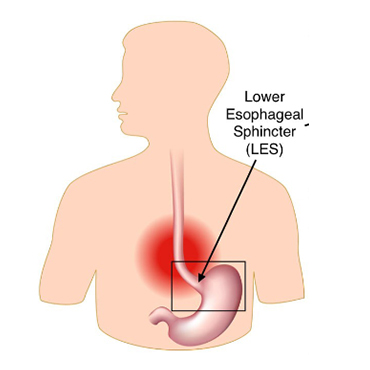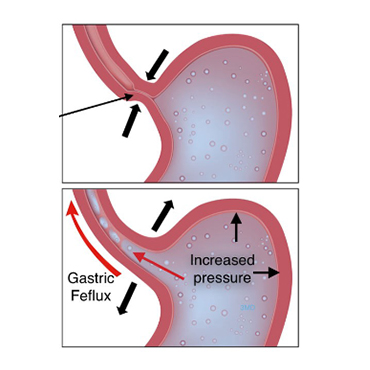GERD – GASTROESOPHAGEAL REFLUX DISEASE
GERD is an uncomfortable and painful condition which affects approximately 5% to 7% of the global population. It may occur in anyone including pregnant women. However, it usually strikes the people who are over 40 years of age. GERD refers to gastroesophageal reflux disease, which is the backflow of stomach contents upward into the oesophagus.
Gastroesophageal Reflux Disease, GERD is a digestive disorder that occurs when a ring of muscles between stomach and oesophagus stops working properly or get weak. Our stomach has a muscle lining called lower oesophageal sphincter which protects the stomach from the effects of its own gastric acids. These muscles open to allow food to pass into the stomach and closes to prevent food and acidic stomach juices from flowing back into the oesophagus. Dysfunction of LES causes the splash up of acid in the oesophagus which begins to damage its lining resulting in heartburn. When this uncomfortable burning sensation becomes frequent or severe enough to cause problems, it is then considered a medical condition is known as GERD.
DISEASES ASSOCIATED WITH GERD
People suffering from obesity and hiatal hernia are more likely to get exposed to acid indigestion or GERD. In, hiatal hernia, the hiatus that links the oesophagus to the stomach becomes enlarged causing the digestive acid in the stomach to go up into the oesophagus. People with severe GERD almost always have a hiatus hernia.
RISK FACTORS THAT MAY INCREASE YOUR CHANCE OF DEVELOPING GERD
The primary causes of Gastroesophageal reflux are when the oesophagus muscles get weak causing the return of stomach acids back to the oesophagus.
GERD can also be caused by excess abdominal fat or through hormone changes during pregnancy or due to an overactive stomach that produces excessive amounts of acid, causing the excess acid to overflow up into the oesophagus.
GERD is usually the results of habits such as smoking, drinking alcohol, coffee tea, cola, and unhealthy eating like chocolate, acidic, fried, fatty or spicy foods. Eating garlic, onions and peppermint also cause GERD.


Another cause is taking certain medications of antidepressants, calcium channel blockers, corticosteroids.
Some of the most common symptoms of GERD
A burning sensation that occurs in the oesophageal area, behind the breast bone which is one of the most common Gastroesophageal Reflux Disease symptoms. This burning sensation usually occurs after a meal.
While other symptoms may include chest pain, excessive saliva, belching, upset stomach, or vomiting. Trouble swallowing, sore throat, and swelling of the vocal cords can also occur in the more serious cases of GERD.
Are there any complications with GERD
If left untreated, Gerd can be a serious disease that can lead to permanent damage to the oesophagus? It can also lead to severe chest pain that feels like a heart attack. GERD can lead to ulcers in the oesophagus as the acid from the stomach damage the cells that line the oesophagus which if uncontrolled can cause bleeding. Scaring, after healing of ulcers in the oesophagus which makes it difficult to swallow as it drastically narrows the oesophagus.
Acid reflux can also increase the risk of cavities or tooth damage. Also, the severely damaged cells in the oesophagus due to acid reflux, mutate and can first become precancerous and later even cancerous, leading to cancer of the oesophagus known as Barrett’s Oesophagus which is precancerous. GERD may affect the nerves of the lower oesophagus that in turn affects the respiratory system and can cause a severe cough or trigger asthma.
IS THERE ANY GERD TREATMENT?
Usually, the people suffering from GERD are suggested lifestyle and dietary changes. But if it’s a severe case your doctor may recommend medications or surgery for Gastroesophageal Reflux Disease treatment.
Procedure in case of chronic cases can be nonsurgical like Stretta procedure or can be laparoscopic surgery like fundoplication of gastric bypass in case morbid obesity is associated with it.
Stretta is a long-lasting solution to treat the GERD symptoms which is beneficial for patients as it lessens the dependency on medications.
Stretta is a non-surgical procedure that involves heating of oesophageal tissues using radio frequency energy. This creates a scar tissue, which helps in strengthening the muscle between the stomach and oesophagus and thus improving reflux.
The procedure is guided endoscopically, and it is done under deep sedation so that maximum patient cooperation can be obtained, and the patient can return to normal everyday activities within a few days.
WHICH TEST HELPS IN THE DIAGNOSIS OF GERD?
The appropriate way to address GERD depends on the nature and severity of the condition. If heartburn persists for a long time, you might need to get tested.
Barium swallow radiograph: An X-ray imaging is done by giving the patient a chalky solution to swallow, which coats the lining of their digestive system which can visualize the internal damage. This test helps in checking hiatal hernia.
Biopsy: Biopsy is done by collecting a tissue sample through the endoscope for examination of the oesophagus cells under a microscope to assess for damage.
Oesophageal acid testing procedure: It is done by placing a thin plastic catheter into the oesophagus and extracts some of the acids in the oesophagus to determine whether you have GERD or not.
Endoscopy: It is done by inserting a tube (endoscope) which contains a camera, into the oesophagus, which allows to examine the inside of the oesophagus and the stomach.
HOW LONG IT TAKES FOR RECOVERY?
The Stretta procedure is a minimal invasive GERD treatment in Dubai, that takes approximately 45 minutes with about 4- 6 hours of recovery time. It takes approx. two to three months to provide optimal benefits. This procedure helps most patients to live without medicines while some patients can manage with a smaller dose of medicines. Book an appointment today with Dr. Girish Juneja.

